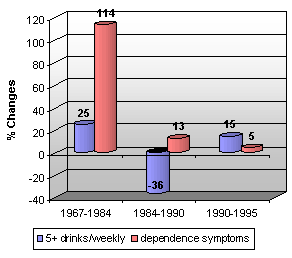The Stanton Peele Addiction Website, March 4, 2000
Trends in American Drinking and Drinking Problems
Drinking Less and Suffering More
Stanton Peele
A remarkable thing has been occurring in the United States. Although national surveys of drinking practices have found that heavy drinking has gone down, more people are reporting drinking problems, and particularly dependence symptoms. The Alcohol Research Group (ARG) conducts National Alcohol Surveys (NASs) about every five years. Between 1967 and 1984, heavy drinking (measured as having five or more drinks at one time at least once weekly) increased slightly, but dependence symptoms increased radically. Between 1984 and 1990, heavy drinking declined somewhat, but those reporting (3+) dependence symptoms increased somewhat. Between 1995 and 2000, both consumption and problems leveled off. Here is a summary of the overall changes in heavy drinking and those reporting dependence symptoms for the years 1967, 1984, 1990, 1995. The point is, contrary to claims by epidemiologists at the ARG and elsewhere, there is not a good relationship between drinking levels and heavy drinking and severe alcohol problems, such that reducing drinking can be expected to reduce drinking problems and alcoholism.
| % Changes in Heavy Weekly Drinking/Dependence Symptoms, 1967-1984-1990-1995 |
|
The Gallup Polls make a similar point. Gallup has been questioning Americans about drinking habits and, more recently, problems drinking has caused in their families. The highest level of abstinence reported by Americans in the sixty years that Gallup has asked this question occurred between 1989 and 1990 (43-44%), after which drinking increased somewhat. However, the percentage of Americans reporting a drinking problem in their family has increased, until it reached its highest point (over a third of respondents) in 1999 (Newport, 1999). Once again, while drinking has diminished or leveled off, the percentage of people reporting drinking problems has increased. Alcohol authorities might say this is because people are learning to recognize the symptoms of abuse. But another possibility is that public health authorities are educating people to think that they have drinking problems, where in the past they drank comfortably.
That social trends influence whether people experience alcohol problems irrespective of how much they drink is a strange concept to most American public health authorities. But a recent study commission by the National Institutes of Health and World Health Organization to test the cross-cultural applicability of alcohol dependence assessments revealed exactly this. What people consider an alcohol problem, and even whether they experience one and of what type, varies tremendously across cultures. The investigators noted that the inevitable correspondence assumed by diagnostic tools between consumption and problem appearance was simply not supported by their cultural investigation (Schmidt et al., 1999).
Finally, two clinical psychologists, Walitzer and Connors (1999), note this surprising failure for alcohol problems to diminish given the decline in consumption. They discuss how most drinking dysfunction is milder than full-blown alcoholism or alcohol dependence. Many of this group with drinking problems, they find, can reduce their drinking rather than abstaining. In fact, for many such individuals drinking reduction is more readily achieved than abstinence. This analysis dictates a different public health and clinical view of drinking problems, one where the effort should be to reduce drinking within healthy levels, rather than the kind of temperance attitudes expressed in insisting that all drinkers who ever have a dysfunction should abstain. This paper is important not so much because what it says is new, but because it is published in the NIAAA's official organ, the periodical Alcohol Research & Health.
References
Greenfield, T.K., Midanik, L.T., and Rogers, J.D. (2000). A 10-year national trend study of alcohol consumption, 1984-1995: Is the period of declining drinking over? American Journal of Public Health, 90, 47-52.
Midanik, L.T., and Greenfield, T.K. (2000). Trends in social consequences and dependence symptoms in the United States: 1984-1995. American Journal of Public Health, 90, 53-56.
Newport, F. (1999, November 3). More than a third of Americans report drinking has caused family problems. Princeton, NJ: Gallup News Service.
Room, R. (1989). Cultural changes in drinking and trends in alcohol problem indicators: Recent U.S. experience. Alcologia, 1, 83-89.
Schmidt, L., Room, R., and collaborators. (1999). Cross-cultural applicability in international classifications and research in alcohol dependence. Journal of Studies on Alcohol, 60, 448-462.
Walitzer, K.S., and Connors, G.J. (1999). Treating problem drinking. Alcohol Research & Health, 23, 138-143.






